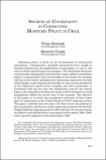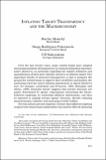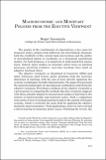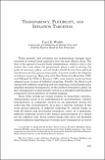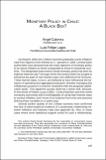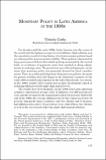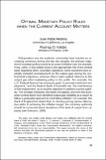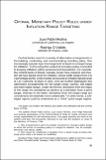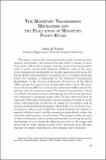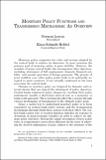Search
Now showing items 31-40 of 40
Sources of uncertainty in conducting monetary policy in Chile
Monetary policy is made in an environment of substantial uncertainty. Consequently, academic researchers have sought to formally demonstrate the implications of uncertainty, as well as the ways in which central banks can manage it. The theoretical literature on uncertainty distinguishes between three ...
Inflation target transparency and the macroeconomy
Over the last twenty years, many central banks have adopted increasing standards of transparency in communicating their monetary policy objectives, in particular regarding the explicit definition and quantification of their price stability objective or inflation target. One important benefit of increased ...
Macroeconomic and monetary policies from the eductive viewpoint
The quality of the coordination of expectations, a key issue for monetary policy, obtains from different, but interrelated, channels: both the credibility of the central bank intervention and the ability of decentralized agents to coordinate on a dynamical equilibrium matter. For both purposes, it is ...
Transparency, flexibility, and inflation targeting
Three parallel and certainly not independent changes have occurred in central bank practices over the past fifteen years. The first is the spread of central bank independence, which is tied to the notion that even when the government plays a role in setting the goals of monetary policy, central banks ...
Monetary policy in Chile: a black box?
During the 1990s the Chilean economy gradually cut its inflation rate from figures in the thirties to 4.7 percent in 1998. Central bank authorities have declared that the main objective of monetary policy is to reduce inflation to levels comparableto those in industrial countries. The desgnated ...
Monetary policy in Latin America in the 1990s
For decades until the early 1990s, Latin America was the region of the world with the highest average level of inflation. High inflation was the cumulative result of a long history of activist economic policies based on a disregard for macroeconomic stability. These policies culminated in large ...
Optimal monetary policy rules when the current account matters
Policymarkers and the academic community have reached an increasing consensus during the last two decades: the primary objective of monetary policy should be to control inflation (see, for example, King, 1999). A less settled issue is the appropriate role of the central bank regarding other, secondary ...
Optimal monetary policy rules under inflation range targeting
Central banks resort to a variety of alternative arrangements in formulating, conducting, and communicating monetary policy. One increasingly popular type of arrangement is based on a target range for inflation. In this setup the conduct of monetary policy is oriented to keeping inflation withing ...
The monetary transmission mechanism and the evaluation of monetary policy rules
This paper explores the connection between the monetary transmission mechanism -the channel through which a change in monetary policy affects the economy- and the choice of monetary policy rules to guide central bank decisions. Differente views of the monetary transmission mechanism are readily apparent ...
Monetary policy functions and transmission mechanisms: an overview
Monetary policy comprises the rules and actions adopted by the central bank to achieve its objectives. In most countries the primary goal of monetary policy is price stability. However, the mandate of many central banks also encompasses other objectives, including attainment of fullemployment, domestic ...

